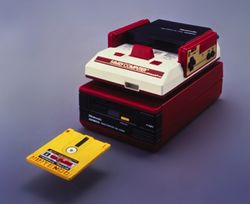Difference between revisions of "Famicom Disk System"
m (→Music and Sound) |
|||
| Line 18: | Line 18: | ||
==Music and Sound== | ==Music and Sound== | ||
| − | The Disk | + | The Famicom Disk System contains the [[Ricoh]] [[RP2C33]], which allows a 32-byte pulse wave, 32-volume channel of wavetable synthesis. This could be used in conjunction with the Famicom's [[RP2A03]] for higher fidelity. |
==Links== | ==Links== | ||
* [http://en.wikipedia.org/wiki/Famicom_disk_system en.wikipedia.org/wiki/Famicom_disk_system] - Wikipedia. | * [http://en.wikipedia.org/wiki/Famicom_disk_system en.wikipedia.org/wiki/Famicom_disk_system] - Wikipedia. | ||
Revision as of 13:30, 27 February 2022
| Famicom Disk System | |
 |
|
| Released: | 1986-02-21 |
| Discontinued: | 2003-??-?? |
| Developer: | Nintendo |
| Type: | Hardware |
- For the music, see Family Computer Disk System (FDS).
The Famicom Disk System (ファミコンディスクシステム Famikon Disuku Shisutemu) is a disk-based peripheral for the Japanese version of the NES (Famicom) released on February 21, 1986. The system attached inside the Famicom's cartridge slot. The console allowed for better graphics and sound. It also gave players the ability to save their games on the disk instead of using the typical password system (battery backups had yet to be developed). The console used what were called Disk Cards which were basically revamped floppy disks. Some games released for the NES and/or Famicom were ported to the Disk System, but most of the time, they didn't take advantage of the console's capabilities.
While the Famicom Disk System is merely an add-on of the Famicom, it is considered a separate platform by this wiki in order to accommodate its unique audio capabilities.
Games
Music and Sound
The Famicom Disk System contains the Ricoh RP2C33, which allows a 32-byte pulse wave, 32-volume channel of wavetable synthesis. This could be used in conjunction with the Famicom's RP2A03 for higher fidelity.
Links
- en.wikipedia.org/wiki/Famicom_disk_system - Wikipedia.